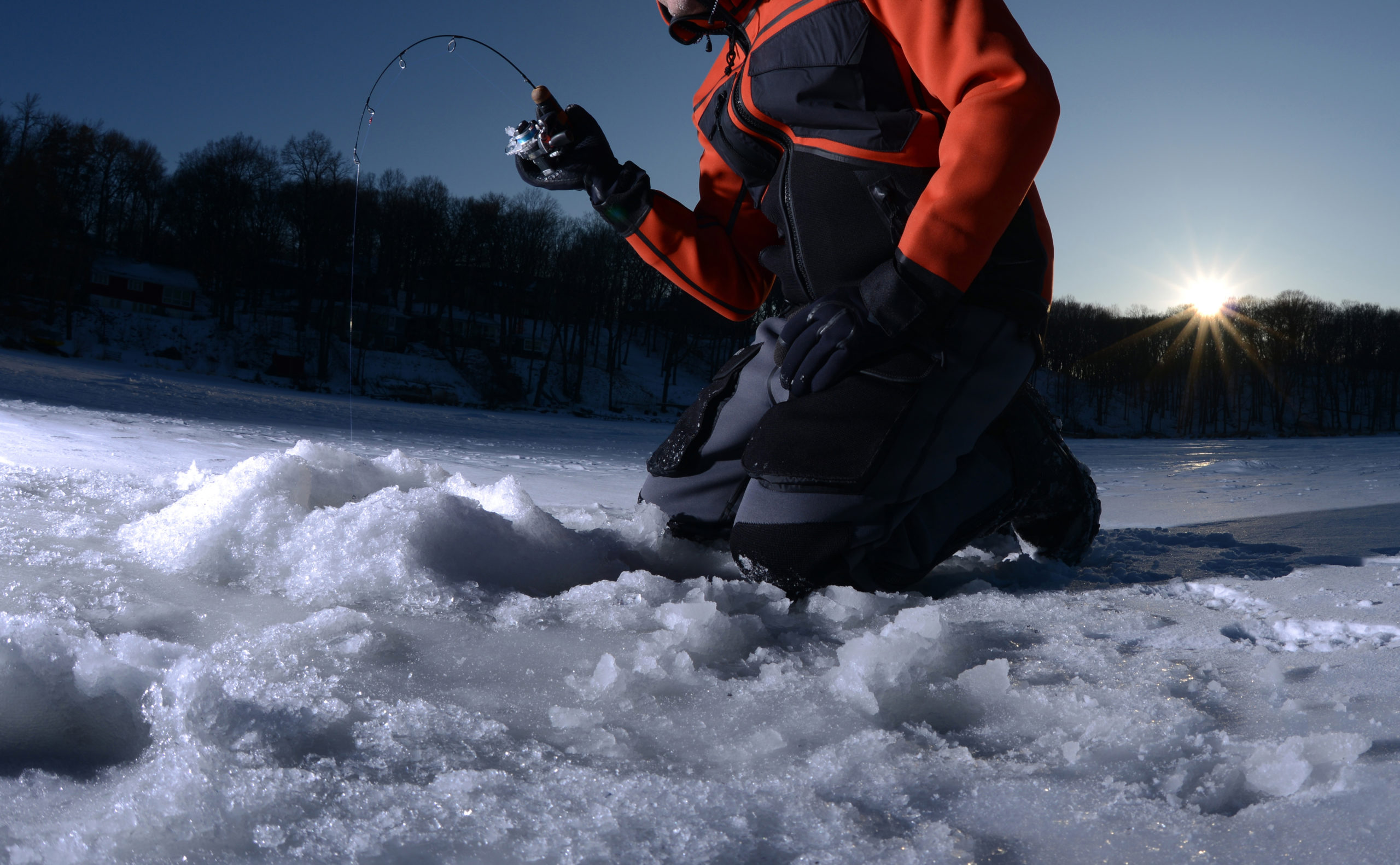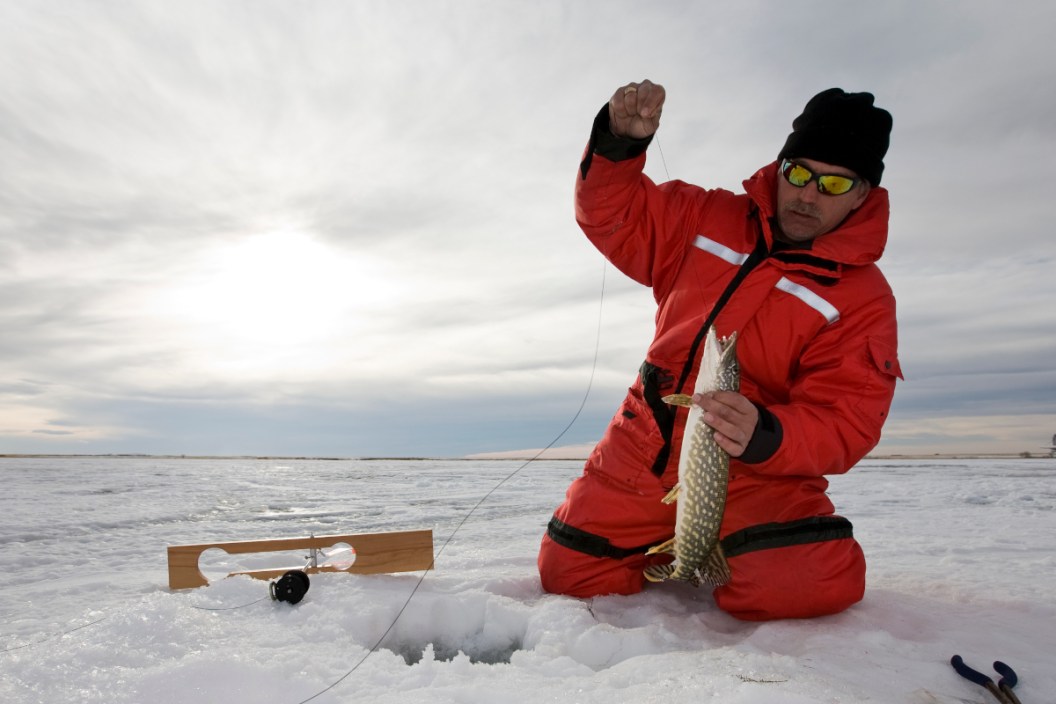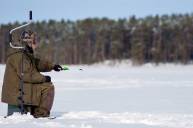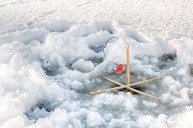Safety first is key whenever you go ice fishing.
As the dead of winter sets in, anglers everywhere are gearing up for one of the few outdoor activities you can enjoy once the water freezes. We're talking about ice fishing of course. However, thin ice can pause a serious hazard on the frozen lakes this time of year if you do not know the danger signs.
Because falling in cold water is not just a drowning hard. One also risks hypothermia and frostbite if they do not dry off and warm up right away.
Don't worry, it's not too hard to judge ice conditions. We have a bevy of ice fishing safety tips that will help you know what to look for the perfect hard water.
How thick is safe for ice fishing?

Getty Images: FtLaudGirl
Before we even talk thickness of the ice, let us just remind everyone that you should ALWAYS be cautious on the ice. Most state agencies like the Minnesota Department of Natural Resources will tell you ice is never one hundred percent safe. However, there are some good rules of thumb that should keep you safe. First and foremost, if there is less than four inches of ice, authorities recommend staying off it completely.
Minnesota's ice thickness guidelines recommend at least four inches before it is safe to go fishing. Keep in mind, this is fishing on foot with your ice auger and other ice fishing gear. If you are planning on using ATVs or snowmobiles, most state agencies recommend at least five to seven inches. That's about the minimum thickness for a wooden ice shanty too. And if you want to drive a car or small pickup truck on the ice, at least eight to twelve inches of ice is recommended.
For those who want to drive a medium to large-sized pickup to their favorite spot. The minimum thickness for safe ice is usually at least a foot or more.
Other factors that affect ice.
No fish is worth your life! As lakes across Minnesota freeze, remember that your safety is your responsibility. Check the ice thickness for yourself, and check it frequently. https://t.co/ZZYGTljTlW #IceSafety #MN pic.twitter.com/PXekoPE9e0
— Minnesota DNR (@mndnr) December 4, 2021
The recommendations above from the Minnesota DNR are assuming new ice. Ice anglers can usually identify it because it is also clear ice. Just keep in mind new, clear ice is almost always going to be the strongest you'll encounter. Keep an eye out for dark or slushy ice. This is usually an indication of old ice, and there is a chance it's much thinner than what you're standing on. Remember that solid ice often varies in thickness. One area may be three feet thick while a hundred yards away it's only a few inches. This is usually how people get in trouble on the ice.
It's not just dark ice you should keep an eye on either. Also watch closely for white ice or ice that is covered by snow. As cold as it is, snow often acts as an insulator and can cause ice under it to warm and weaken significantly. Depending on the amount of snow, it can also put excess weight on the ice and strain it. Most experts recommend doubling up the ice thickness guidelines to determine if it is safe. So, instead of four inches of ice for safe angling, eight inches covered in snow is what is going to be safe.
Slush is also a good indicator the ice you are seeing is likely not safe. This type of ice is usually only half as strong as new ice, and it may be close to turning back into open water again. Just avoid it and you should be good to go. If you are confused at all about the condition of the ice, head to the local boating launch. Talk to the anglers there to get a feel of the ice. Another option is to call the local bait shop, or to contact a game warden. They will have their finger on the pulse of how the ice fishing is going currently.
Another important safety tip comes from the Colorado Parks and Wildlife Department. Keep an eye out for pressure ridges of raised ice. These often look like little mountains forming in the middle of the lake. They are often a sign of ice that is melting, expanding, and contracting. Odds are, they're also highly unstable 20 to 30 feet from the ridges. Keep away from them.
Safety gear.
One of the first pieces of gear you should own is an ice pick or ice chisel. Before you get started drilling holes you should use one of these to test the ice near the shoreline for thickness. You can also use an ice auger or even a small shovel for this task. Just make sure you're getting an idea of what the ice is like before you ever step foot on it.
Another vital piece of gear should be some ice picks. You can buy these in a store, but they can also be made cheaply and easily at home. They are usually just spikes or nails protruding from the end of a wooden dowel. Attach the two with a cord and keep them around your neck. If you fall through the ice, jam the spikes into the ice to pull yourself out again. This is a vital piece of gear if you are planning on fishing solo.
If you have an ice shanty or are planning to drive a vehicle on the ice, it's not a bad idea to have some sort of flotation device handy too in case you go through. Just a simple life vest or a throwable flotation device should do the trick. Just make sure it's easily accessible in a situation where your shanty or vehicle happens to break through. It may seem silly to take a life jacket ice fishing, but it could buy some precious seconds while others mount a rescue. It may even save someone's life.
Most accidents happen when people ignore these rules.
If you talk to any angler who has had the misfortune of falling through the ice, you will often find one thing in common with these incidents. They often ignored telltale warning signs the ice was not a hundred percent safe. It's the same if you talk to search and rescuers who respond to these types of things. Most incidents are entirely avoidable with a little common sense and following of these guidelines. . Just remember you have friends and family who are counting on you coming home safely. We do not care how good the fishing is, it is never worth risking your life to catch them.
Products featured on Wide Open Spaces are independently selected by our editors. However, when you buy something through our links, we may earn a commission.
For more outdoor content from Travis Smola, be sure to follow him on Twitter and check out his Geocaching and Outdoors with Travis YouTube channels.
NEXT: PIKE SPEARING BRINGS AN EXCITING CHALLENGE TO TRADITIONAL ICE FISHING
WATCH





